Pumpkin Sourdough Bread is a delightful twist on traditional sourdough, featuring the warm, comforting flavor of pumpkin blended right into the dough. This bread has a lovely soft crumb with a slightly tangy crust, and the pumpkin adds a subtle sweetness and beautiful golden color that makes every slice feel like fall in your hands.
I love baking this bread when the weather starts to cool down because it fills the kitchen with the cozy smell of pumpkin and yeast working their magic together. It’s fun to watch the dough rise and transform, and I always feel proud when I pull that golden loaf from the oven. A little tip I’ve learned is to add a few spices like cinnamon or nutmeg for an extra warm note, but even plain pumpkin in the sourdough is just wonderful.
This bread is fantastic for breakfast toasted with a bit of butter or for making sandwiches with your favorite fillings. I especially enjoy spreading cream cheese on it for a simple snack. Whenever I make pumpkin sourdough, it brings back memories of crisp autumn mornings and gatherings around the table with friends and family, sharing good food and laughter.

Key Ingredients & Substitutions for Pumpkin Sourdough Bread
Bread Flour: Bread flour gives the dough strength and chewiness. If you can’t find it, all-purpose flour works too, though your bread might be a bit softer.
Active Sourdough Starter: Your starter needs to be bubbly and active for this recipe. If you don’t have one, you could use commercial yeast, but the flavor won’t be as complex.
Pumpkin Puree: Use canned or fresh pumpkin puree without added sugars. Sweet potato or butternut squash puree can be fun alternatives if you want a slightly different flavor.
Water: Adjust the amount depending on your pumpkin’s moisture and the flour’s absorption. Lukewarm water helps activate the yeast in the starter.
Spices: Cinnamon and nutmeg add warmth but are optional. You can leave them out or try other fall spices like ginger or allspice for variation.
How Do You Perfect the Stretch and Fold Technique in Sourdough Baking?
Stretch and folds are key for building your dough’s strength without kneading. They help develop gluten and trap air for a light crumb.
- Wet your hands to prevent sticking.
- Lift one side of the dough and gently stretch it up without tearing.
- Fold it over the rest of the dough, then turn the bowl and repeat on all sides.
- Do this 4 times every 30 minutes during the first 2 hours of fermentation.
Be gentle but thorough. Stretch and folds give your bread a nice structure and can make shaping easier later on.
Equipment You’ll Need
- Large mixing bowl – big enough for dough to rise and easy to mix ingredients without mess.
- Dutch oven or baking stone – helps create a steamy environment for a crispy crust.
- Banneton or bowl with a towel – supports your dough shape during final rise and adds nice texture.
- Sharp bread lame or knife – for scoring the dough to control how it expands in the oven.
- Kitchen scale – essential for accurate measuring of flour, water, and other ingredients.
Flavor Variations & Add-Ins
- Add 1/4 cup chopped walnuts or pecans for a crunchy texture that pairs well with pumpkin.
- Stir in 1/4 cup raisins or dried cranberries for a touch of sweetness and chewy bites.
- Mix in 1 tsp ground cloves or ginger along with cinnamon for a spicier fall flavor.
- Swap pumpkin puree for cooked sweet potato to keep the color and add natural sweetness.

How to Make Pumpkin Sourdough Bread?
Ingredients You’ll Need:
- 500 g bread flour
- 100 g active sourdough starter (100% hydration)
- 150 g pumpkin puree (cooked and pureed, unsweetened)
- 320 g water (adjust as needed)
- 10 g salt
- 1 tsp ground cinnamon (optional for warm flavor)
- ½ tsp ground nutmeg (optional for warm flavor)
- Extra flour for dusting
How Much Time Will You Need?
This recipe takes about 30 minutes of hands-on preparation, with 4-6 hours of room-temperature fermentation, followed by an overnight chill of 8-12 hours, and finally about 45 minutes to bake. Most of the time is for fermenting and resting, so you can prepare in the morning and enjoy fresh bread the next day.
Step-by-Step Instructions:
1. Mixing Ingredients and Autolyse:
In a large bowl, mix the bread flour, cinnamon, and nutmeg (if you’re using them). In another bowl, combine your sourdough starter, pumpkin puree, and water. Pour the wet mix into the dry flour and stir until it forms a rough, shaggy dough. Let it rest for 30 minutes—this helps the flour absorb moisture.
2. Adding Salt and Stretch & Folds:
After resting, add the salt to the dough and mix it in by folding and pinching the dough gently. Then, every 30 minutes for 2 hours, perform a “stretch and fold” by pulling the dough up and folding it over itself. This strengthens the dough and builds gluten.
3. Bulk Fermentation and Shaping:
Cover the dough and let it rise at room temperature until it doubles—this usually takes 4 to 6 hours depending on your starter and room temperature. Once risen, gently turn the dough onto a floured surface and shape it into a tight round ball (a boule) by folding the edges underneath.
4. Cold Proof and Prepare to Bake:
Place your shaped dough seam-side up in a well-floured banneton or bowl with a floured towel. Cover it and refrigerate overnight for 8 to 12 hours—this slows fermentation and deepens flavor.
5. Baking Your Bread:
Preheat your oven to 250°C (480°F) with a Dutch oven or baking stone inside for at least 30 minutes. Take the dough out from the fridge and flip it carefully onto parchment paper. Score the top with a sharp knife or lame to help it rise evenly. Place the dough (with parchment) into the hot Dutch oven or onto the stone. Cover if using a Dutch oven.
Bake covered for 20 minutes, then remove the lid and reduce heat to 220°C (430°F). Bake for 20 to 25 more minutes until the crust turns golden and crispy. Let the bread cool completely on a rack before slicing.
Enjoy the warm pumpkin aroma and the slightly tangy, soft crumb that makes this sourdough bread special. It’s perfect toasted, for sandwiches, or simply with a touch of butter!

Can I Use Frozen Pumpkin Puree?
Yes! Just make sure to thaw it completely and drain any excess liquid before using. This helps keep your dough from getting too wet.
How Should I Store Leftover Pumpkin Sourdough Bread?
Store leftover bread in a paper bag or bread box at room temperature for up to 3 days. For longer storage, slice and freeze it in an airtight bag—toast slices straight from the freezer!
Can I Skip the Spices in This Recipe?
Absolutely! The cinnamon and nutmeg add warm fall flavors but are optional. The bread will still be delicious and have a lovely natural pumpkin taste without them.
What If My Dough Doesn’t Rise Much?
If your dough is slow to rise, it might be due to a less active starter or cooler room temperature. Try giving it more time to ferment or warm up your kitchen slightly to encourage a better rise.
